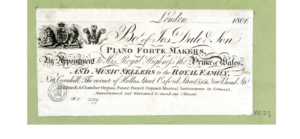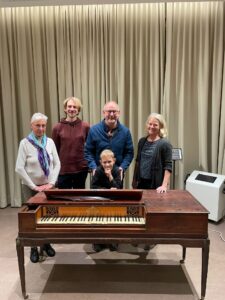Joseph Dale & Son 1806 – 1809
Description

| Date: | 1806 - 1809 |
| Origin: | London |
| Serialnumber: | 304 |
As part of the workshop “Herangetastet. Eine Spurensuche” hosted by the “betont – Ton und Tasten Museum” in Kellinghusen, an instrument by Joseph Dale was expertly examined on November 16. Together with museum director Dr. Jan-David Mentzel and collector and expert Eric Feller, the workshop participants explored the instrument in detail. The square piano was acquired in March 2018 at an auction house in England. No evidence of previous restorations was found, indicating that the instrument was in its original condition.
The case and stand of the instrument are made of mahogany and adorned with multi-coloured inlays. The action features a single action with underdampers, double-stringing, and a pedal for lifting the dampers, which is missing. The lower keys are covered with ivory, while the upper keys are made of ebony. The nameboard of the instrument shows the following inscription within an oval cartouche:
“Joseph Dale & Son
Piano Forte Makers
(By Appointment) To His Royal Highness
The Prince of Wales
Cornhill, Oxford Street & New Bond Street
London.”
This square piano is dated between 1806 and 1809. In 1805, Joseph Dale entered into a partnership with his son, William Dale, and both were granted the privilege of supplying instruments to the English royal family (“By Appointment To His Royal Highness / The Prince of Wales“). This distinction was prominently advertised by the company, as evidenced by the Prince of Wales’ heraldic badge—a green-painted emblem of three ostrich feathers—located above the inscription on the nameboard. Between 1806 and 1809, the Prince of Wales was George Augustus Frederick, the future King George IV. He was the eldest son of King George III and held the title of Prince of Wales from 1762 until his accession to the throne in 1820. In 1809, William Dale left his father’s company and established his own business under his own name.

Square Piano Joseph Dale & Son, London 1806 – 1809 – nameboard – Eric Feller Collection
During the examination, the monogram “J D” of Joseph Dale was found handwritten in ink beneath the action. Additionally, the serial number 304 was inscribed in ink on the wrest plank. A historical metal quill pen was also discovered inside the instrument.

Joseph Dale & Son, London 1806 – 1809 – Signature by J. Dale – Eric Feller Collection
Joseph Dale was born in 1750 and worked as an instrument maker and music publisher. In 1783, he opened his business at 132 Oxford Street, and shortly thereafter, at 19 Cornhill Street. In 1805, he entered into a partnership with his son William Dale (born circa 1780–1785, died circa 1827). The following year, their business received significant recognition by being appointed as instrument makers to the Prince of Wales and the royal family.

Trade Card 1806 Joseph Dale and Son – The British Museum
In 1809, William decided to establish his own business, while Joseph continued to work independently from 1808 until his death in 1821. William Dale passed away in 1827, and his wife Elspeth Dale continued to run the business until 1832.
Other Surviving Instruments by Joseph Dale & Son:
- Circa 1805 square piano – Sigal Music Museum, Greenville, USA
- Circa 1805 square piano – Private Collection, Haxby, England

Workshop Results 1 – Museum betont – Eric Feller Collection

Workshop Results 2 – Museum betont – Eric Feller Collection
Workshops of this kind will be held regularly at the “betont – Ton und Tasten Museum” in Kellinghusen. Further dates can be found on the museum’s website.
https://www.kellinghusen.de/museum

Workshop – Eric Feller Collection
| Length: | 161 cm |
| Width: | 62 cm |
| Height: | 23,5 cm |
| Circumference: | 5 ½ octaves (FF – c4) |
| Mechanics: | Single Action (underdampers) |
| Pedals: | 1 pedal (dampers) |
| Signature: |
"Joseph Dale & Son Piano Forte Makers (By Appointment) To His Royal Highness The Prince of Wales Cornhill, Oxford Street & New Bond Street London." |

